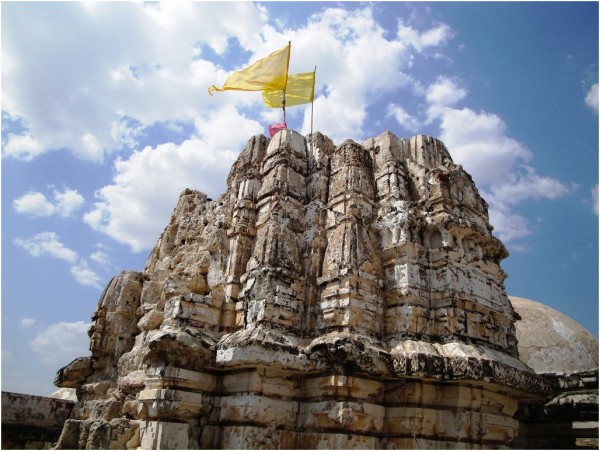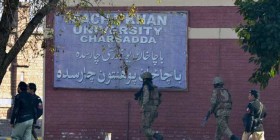Pakistan’s long forgotten Hindu temples. After India gained independence, a large chunk of Hindus and Sikhs migrated from Pakistan to India. Similarly, nearly an equal number of Muslims left India to live in Pakistan. Today, only 26 out of Pakistan’s 428 Hindu temples exist. There are many examples of such ancient architecture; silent testimonies of our heritage, narrating tales of our past and stories of our land. Unfortunately, these exponents of our history are in a state of utter neglect. Let’s take a look at some such temples…
1. Katasraj temple: Katasraj Mandir is a temple complex situated in Katas village in the Chakwal district of Punjab in Pakistan. Dedicated to Shiva, the temple has existed since the days of Mahabharata and the Pandava brothers spent a substantial part of their exile at the site. The smaller temples, built in pairs around the larger central temple, were built around 900 years or so ago, although the earliest of them dates back to the latter half of the 6th century AD.
Many legends are associated with the temples. Legend says that the five Pandava brothers stayed here for four out of the 14 years that they spent in exile. The lake in the complex is believed to have magical powers and is supposed to be where Yudhisthira defeated the Yaksha with his wisdom to bring his brothers back to life.
Another legend involves the death of Shiva’s wife Sati; the story goes that when she died he cried so much and for so long that his tears created two holy ponds – one at Pushkara in Ajmer and the other at Ketaksha, which literally means “raining eyes” in Sanskrit. It is from this name that the word Ketas is derived. Another version of the legend mentions the two pools at Katasraj and Nainital.
The temple complex was not abandoned by Hindus when they migrated to East Punjab in 1947. Worshippers of all faiths perform pilgrimage to the mandir. The pilgrims bathe in the sacred pool and seek forgiveness as a belief holds that bathing in the pond (especially on certain occasions) leads to the forgiveness of sins and helps attain salvation. Until recently, it was believed that the pond had unlimited depth.
For decades the temple complex was in bad state. The holy pond was littered with garbage, while the murals inside the temples disappeared due to the ravages of time and the neglect of the authorities. In 2006-07, Pakistan governments decided to place murtis of Hindu gods in the seven mandirs and restore them to their original state to attract visitors.
The Katas site houses the Satgraha, a group of seven ancient temples, remains of a Buddhist stupa, a few medieval temples, havelis and some recently constructed temples, scattered around a pond. The mandir has two jharokas (balconies) that have been severely damaged. The temple’s ceiling is undecorated, and lime-plastered.
2. Hinglaj temple: According to ancient scriptures, Lord Rama had also meditated at Hinglaj to atone for his sin of ‘Brahmhatya’ – killing of Ravana who was a Brahmin and a great devotee of Lord Shiva and Goddess Durga. Each year they organize a grand cultural-fair at this temple. Muslim residents actively take part in this celebration. They worship the Goddess with the same devotion as Hindus.
The temple is not in a very good state. The chairman of the committee that manages the famous Hinglaj Mata temple was kidnapped just two days before the beginning of the shrine’s annual pilgrimage, according to a media report in April 2012.
3. Gori temple: The Jain temples of Tharparkar are among Pakistan’s major archaeological monuments. The most impressive of them all, Gori Temple, is located in the village of Gori between Islamkot and Nagarparkar in Tharparkar district. This partly ruined temple is mysterious since it has been abandoned for a long time. Authors in the past have yearned to find out about the current status of this long lost place of worship.
The Gori temple was dedicated to Lord Parshwanath, the 23rd Jain prophet who preached in the 8th century BC. Several Jain texts give an account of the history of the temple and legends surrounding it. The text “Shri Gaudi Parshvanath Stavan” by Nemavijaya was written in Tharparkar region itself. The temple is built in the classical Jain style. It has one main temple surrounded by 52 smaller shrines, each housing one or more images of Jain prophets. It has 52 domes and its interiors were adorned with paintings.
Gori temple became a famous pilgrimage centre. Setting aside legends and tradition, there is still something that makes the Gori temple unique – the paintings within the ranga-mandap dome. These paintings are older than any other frescos in the Jain temples of North India, with the exception of Ellora. In India, the temples have been renovated and any old frescos have been painted over. Gori paintings are also older than any other surviving frescos in Pakistan, with the possible exception of some Gandhara fragments.
4. Mari Indus temple: High above the mighty Indus temples were built from the sixth to the eleventh centuries A.D. Largely ignored by scholarship in this century, and orphaned since partition, these structures form an important missing link in the history of architecture. The far northwest in ancient India what now is the Northwest provinces of Pakistan, Swat, and parts of Afghanistan has many structural remains we can associate with Hindu mythology.
5. Sharada Peeth: Sharada Peeth, located near Sharda in Pakistan-occupied-Kashmir (Pok), is the famous temple of goddess Sarasvati (Sharda) on the banks of Kishenganga River. Its ruins are near the Line of Control (LOC) between the Indian and Pakistani-controlled portions of Kashmir and Jammu. Kashmir was a high established centre of learning of vedantic works until invaders from central-Asian countries came and destroyed it. Indigenous script of Kashmir is named after the deity Sharada Devi.
It is one of the most established Shakti Peethas formed due to the falling of body parts of the corpse of Sati Devi, when Shiva carried it and wandered throughout Aryavartha in sorrow. There are 51 Shakti Peeth linking to the 51 alphabets in Sanskrit. Each temple has shrines for Shakti and Kalabhairava. Sharada Peeth is one of the 18 Maha Shakti Peetha. Devi’s Right hand is said to have fallen here. The Shakti worshiped here is the goddess of knowledge, Saraswathi otherwise known as Sharada.
Prior to the partition, a fair was held at village Shardi in the month of Bhadrapada and on the eighth day of the Shukla Paksha, and devotees from all over India, flocked the place in thousands, for receiving the blessings of the Mother Sharada deity. There is a place called “Tikkar” at a distance of one and half kilometers from Kupwara, in Kashmir. From here, there is a short cut for going to Shardi which measures 40 kilometers. Many Pilgrims treaded this path only.
6. Guru Gorakhnath temple: The Gorakhnath temple is named after the Guru Gorakhnath achieved prosperity in this city and also influenced followers with his teachings. It is said that this temple was built on the spot where Gorakhnath did meditation in Treta Yug. The temple is situated in the Gorgathri neighbourhood in Peshawar. Gorakhnath temple was reopened in 2011 after a long legal fight or 60 years as the temple was forcefully closed by the Evacuee Property Trust Board and the Provincial Archaeology Department of Pakistan.
7. Gorakh Degi : It is said that Sikh Gurus used to jump into the well inside the Guru Gorakhnath temple and appear in Gorakh Degi on Warsak Road miles away. Gorakh Degi, along with most other religious sites in Peshawar, was abandoned after the partition.
8. Kalyan Das temple: In the middle of the area that is commonly known as Kohati Bazaar, one can see the dome of a temple which is almost hidden by the high walls of an academic institution. Here stands one of the beautiful, historic landmarks of the Rawalpindi: Kalyan Das Temple. Outside this building, there is a Government Qandeel Secondary School for visually impaired children.
On entering the main gate of the school, one is at once confronted with the sight of a magnificent architectural form which stands right in the middle of the school courtyard. This temple was named after a generous resident of Rawalpindi, Kalyan Das, who laid its foundation stone in 1850s, and as confirmed by the board – it is said that it was completed in 1880.
The Kalyan Das temple is believed to have had more than a 100 rooms and was spread over an area of about seven acres, besides a vast pond around the main temple building. Like many other temples of the city, during the partition of India, Kalyan Das temple was also left abandoned as the Hindu population left the city. Today this magnificent architectural piece still stands tall but the complex it is in is a state of decay.
The beautiful paintings engraved on the walls of the temple are fading away; the damp roof of the main architecture pours in rainy days. The rooms of the main complex are used as store rooms and are kept locked. The idols are missing but their marks attract the attention of visitors. The many spires in the temple complex are still imposing but years of neglect has made them colourless. The white paint used to brighten the complex has, in fact, buried its original floral work.
9. The Panj Tirath: Panj Tirath, which got its name from the five pools of water present there, comprised a temple and a spacious lawn with peeple and date trees. Years of neglect, however, was not what brought upon its ultimate demise – it was razed down in the 1970s to make way for the building of what was then known as the Sarhad Chamber of Commerce and Industry.
10. Sri Varun Dev temple: Situated on the seashore off Manora Cantt, Karachi this Temple is about 160 years old and has been specifically designed as per Hindu architecture. The Temple was abandoned & illegally occupied by land grabbers after the 1947 partition. In 2007, Pakistan Hindu Council brought back the sanctity of the Temple by taking a bold step to renovate the same. The Station Commander, PNS Himalaya, Manora Cantt handed over the control of this Temple to Pakistan Hindu Council in June, 2007.
11. The Rama Peer temple: The Rama Peer temple, which some say was 80 years old, was one of many Hindu temples in Karachi that have in recent years been the subject of property disputes involving commercial builders. It was demolished in December 2012 by a Karachi property developer.
Disclaimer:Please note that the sole purpose of this blog is to report about some of the temples situated in Pakistan. This is not a comprehensive list; it does not state any opinion and is not intended to criticize any religious community.






Leave a reply